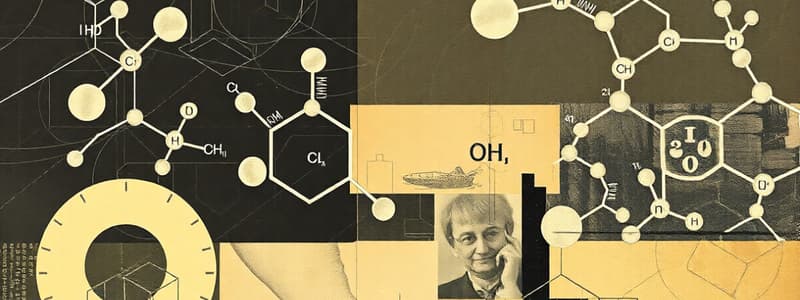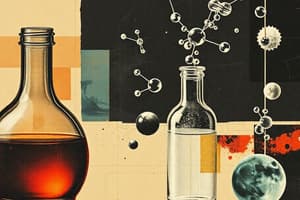Podcast
Questions and Answers
How many moles are there in 5.436 g of phenol (C6H5OH)?
How many moles are there in 5.436 g of phenol (C6H5OH)?
- 0.0632 mol
- 0.0548 mol
- 0.0610 mol
- 0.0578 mol (correct)
What trend in electronegativity occurs as you move across a period on the periodic table?
What trend in electronegativity occurs as you move across a period on the periodic table?
- Electronegativity increases (correct)
- Electronegativity decreases
- Electronegativity varies randomly
- Electronegativity remains constant
Which statement about electronegativity is true for atoms with a valence shell that is more than half full?
Which statement about electronegativity is true for atoms with a valence shell that is more than half full?
- They have the same tendency to lose or gain electrons.
- It is easier for them to lose an electron.
- It is easier for them to gain an electron. (correct)
- They tend to form cations easily.
What is the numerical value of the Avogadro constant?
What is the numerical value of the Avogadro constant?
Which of the following aspects is NOT part of pharmacokinetics?
Which of the following aspects is NOT part of pharmacokinetics?
Which of the following statements about ionic bonds is true?
Which of the following statements about ionic bonds is true?
Which functional group is likely to be polar and ionizable?
Which functional group is likely to be polar and ionizable?
What is the characteristic of organic compounds?
What is the characteristic of organic compounds?
Why is understanding the shape of chemical structures important in pharmacology?
Why is understanding the shape of chemical structures important in pharmacology?
What determines the number of covalent bonds an atom can form?
What determines the number of covalent bonds an atom can form?
Which statement correctly defines the valency of an element?
Which statement correctly defines the valency of an element?
What are lone pair electrons?
What are lone pair electrons?
How is formal charge calculated?
How is formal charge calculated?
In organic chemistry mechanisms, why is the assignment of formal charge considered impractical?
In organic chemistry mechanisms, why is the assignment of formal charge considered impractical?
What happens to a neutral atom that gains two electrons?
What happens to a neutral atom that gains two electrons?
Which of the following statements about formal charge and free radicals is correct?
Which of the following statements about formal charge and free radicals is correct?
Which atom has the highest number of bonds it can form based on its electron configuration?
Which atom has the highest number of bonds it can form based on its electron configuration?
What is the most electronegative element?
What is the most electronegative element?
Which type of electron orbital is characterized as spherical?
Which type of electron orbital is characterized as spherical?
How many electrons can the 1s orbital hold?
How many electrons can the 1s orbital hold?
What is the principle that states electrons occupy the lowest-energy orbitals first?
What is the principle that states electrons occupy the lowest-energy orbitals first?
According to Hund's rule, how should electrons be distributed in degenerate orbitals?
According to Hund's rule, how should electrons be distributed in degenerate orbitals?
Which of the following statements about p orbitals is true?
Which of the following statements about p orbitals is true?
Which of these configurations represents the ground-state electron configuration of Carbon?
Which of these configurations represents the ground-state electron configuration of Carbon?
What shape does a d orbital generally resemble?
What shape does a d orbital generally resemble?
What is the maximum number of electrons that can fit in the third shell?
What is the maximum number of electrons that can fit in the third shell?
What is the nodal plane in the context of p orbitals?
What is the nodal plane in the context of p orbitals?
Which pair of principles describes how electrons behave in orbitals?
Which pair of principles describes how electrons behave in orbitals?
Which of the following best describes the Schrödinger wave equation in relation to electrons?
Which of the following best describes the Schrödinger wave equation in relation to electrons?
In the context of atomic structure, what does the term 'electron cloud' refer to?
In the context of atomic structure, what does the term 'electron cloud' refer to?
What is the primary reason atoms bond to form compounds?
What is the primary reason atoms bond to form compounds?
What characterizes a covalent bond?
What characterizes a covalent bond?
What is the consequence of a difference in electronegativity greater than 1.7?
What is the consequence of a difference in electronegativity greater than 1.7?
What is required to achieve hybridization of s and p orbitals?
What is required to achieve hybridization of s and p orbitals?
What defines an ionic compound?
What defines an ionic compound?
What effect does an electronegative element have in an inductive effect?
What effect does an electronegative element have in an inductive effect?
Which statement about Lewis structures is false?
Which statement about Lewis structures is false?
What is the significance of achieving an octet configuration?
What is the significance of achieving an octet configuration?
In a covalent compound, electrons are generally:
In a covalent compound, electrons are generally:
What is the role of ionization energy in forming ionic bonds?
What is the role of ionization energy in forming ionic bonds?
Which of the following structures represents the shorthand way of writing carbon-based molecules?
Which of the following structures represents the shorthand way of writing carbon-based molecules?
What describes the change in energy when a bond is formed?
What describes the change in energy when a bond is formed?
What does the dipole moment measure in a molecule?
What does the dipole moment measure in a molecule?
What type of bond is formed by the overlap of two atomic orbitals along a line connecting the nuclei?
What type of bond is formed by the overlap of two atomic orbitals along a line connecting the nuclei?
Which hybridisation involves the combination of one s orbital and two p orbitals?
Which hybridisation involves the combination of one s orbital and two p orbitals?
In a carbon-carbon double bond, how many electrons are involved in forming the bond?
In a carbon-carbon double bond, how many electrons are involved in forming the bond?
Which of the following bond angles is most commonly associated with sp3 hybridised carbon?
Which of the following bond angles is most commonly associated with sp3 hybridised carbon?
What is the geometric arrangement around a carbon atom in ethyne (C2H2)?
What is the geometric arrangement around a carbon atom in ethyne (C2H2)?
What is the effect of hybridisation on bond strength in carbon-based molecules?
What is the effect of hybridisation on bond strength in carbon-based molecules?
What type of bond is formed by the side-to-side overlap of unhybridised p orbitals?
What type of bond is formed by the side-to-side overlap of unhybridised p orbitals?
Which hybridisation is depicted by the presence of one unhybridised p orbital and three hybridised orbitals in a planar arrangement?
Which hybridisation is depicted by the presence of one unhybridised p orbital and three hybridised orbitals in a planar arrangement?
What characteristic of a p bond contributes to its rotational barrier?
What characteristic of a p bond contributes to its rotational barrier?
What is the relationship between bond length and bond strength in sigma and pi bonds?
What is the relationship between bond length and bond strength in sigma and pi bonds?
What symmetry does the H-H bond exhibit?
What symmetry does the H-H bond exhibit?
How is the structure of methane (CH4) best described in terms of its angles and shape?
How is the structure of methane (CH4) best described in terms of its angles and shape?
In which molecular structure does a carbon atom use sp hybrid orbitals?
In which molecular structure does a carbon atom use sp hybrid orbitals?
Flashcards
First Pass Metabolism
First Pass Metabolism
The process by which drugs are broken down by the body, usually in the liver. It alters a drug's structure, making it easier to excrete.
Bioavailability
Bioavailability
The amount of drug that reaches systemic circulation after administration. Determined by the drug's absorption, distribution and metabolism.
Binding to Receptor
Binding to Receptor
The interaction of a drug with its specific target site, often a protein or enzyme, which initiates a chain of events leading to the drug's effect.
Time Course of Effect (Pharmacokinetics)
Time Course of Effect (Pharmacokinetics)
Signup and view all the flashcards
Covalent Bond
Covalent Bond
Signup and view all the flashcards
Ionic Bond
Ionic Bond
Signup and view all the flashcards
Shape of Chemical Structure
Shape of Chemical Structure
Signup and view all the flashcards
Functional Groups
Functional Groups
Signup and view all the flashcards
Mole (mol)
Mole (mol)
Signup and view all the flashcards
Molecular Mass (Mr)
Molecular Mass (Mr)
Signup and view all the flashcards
Calculating Moles
Calculating Moles
Signup and view all the flashcards
Electronegativity
Electronegativity
Signup and view all the flashcards
Electronegativity Trend Across a Period
Electronegativity Trend Across a Period
Signup and view all the flashcards
Pauling Scale
Pauling Scale
Signup and view all the flashcards
Quantum mechanical model
Quantum mechanical model
Signup and view all the flashcards
Orbital
Orbital
Signup and view all the flashcards
s orbital
s orbital
Signup and view all the flashcards
p orbital
p orbital
Signup and view all the flashcards
Electron Shell
Electron Shell
Signup and view all the flashcards
Valency
Valency
Signup and view all the flashcards
Degenerate p orbitals
Degenerate p orbitals
Signup and view all the flashcards
Node
Node
Signup and view all the flashcards
What determines the number of bonds an atom forms?
What determines the number of bonds an atom forms?
Signup and view all the flashcards
Ground-state electron configuration
Ground-state electron configuration
Signup and view all the flashcards
Lone pair electrons
Lone pair electrons
Signup and view all the flashcards
Aufbau principle
Aufbau principle
Signup and view all the flashcards
Formal charge
Formal charge
Signup and view all the flashcards
Pauli Exclusion Principle
Pauli Exclusion Principle
Signup and view all the flashcards
Free radical
Free radical
Signup and view all the flashcards
Equation method for formal charge
Equation method for formal charge
Signup and view all the flashcards
Hund's rule
Hund's rule
Signup and view all the flashcards
Orbital Hybridization
Orbital Hybridization
Signup and view all the flashcards
Electron movement in organic chemistry mechanisms
Electron movement in organic chemistry mechanisms
Signup and view all the flashcards
Carbon's bonding properties
Carbon's bonding properties
Signup and view all the flashcards
Charge change based on electron gain or loss
Charge change based on electron gain or loss
Signup and view all the flashcards
Valence Shell
Valence Shell
Signup and view all the flashcards
Hybridization
Hybridization
Signup and view all the flashcards
Dipole Moment
Dipole Moment
Signup and view all the flashcards
Polar Molecule
Polar Molecule
Signup and view all the flashcards
Non-polar Molecule
Non-polar Molecule
Signup and view all the flashcards
Ion
Ion
Signup and view all the flashcards
Ionic Bond (again), but with emphasis on electron transfer
Ionic Bond (again), but with emphasis on electron transfer
Signup and view all the flashcards
Molecule
Molecule
Signup and view all the flashcards
Inductive Effect
Inductive Effect
Signup and view all the flashcards
Skeletal Structure
Skeletal Structure
Signup and view all the flashcards
Valence Electrons
Valence Electrons
Signup and view all the flashcards
Sigma (σ) Bond
Sigma (σ) Bond
Signup and view all the flashcards
Pi (π) Bond
Pi (π) Bond
Signup and view all the flashcards
sp3 Hybridization
sp3 Hybridization
Signup and view all the flashcards
sp2 Hybridization
sp2 Hybridization
Signup and view all the flashcards
sp Hybridization
sp Hybridization
Signup and view all the flashcards
Methane (CH4)
Methane (CH4)
Signup and view all the flashcards
Ethane (C2H6)
Ethane (C2H6)
Signup and view all the flashcards
Ethene (C2H4)
Ethene (C2H4)
Signup and view all the flashcards
Ethyne (C2H2)
Ethyne (C2H2)
Signup and view all the flashcards
Methyl Cation (CH3+)
Methyl Cation (CH3+)
Signup and view all the flashcards
Methyl Radical (CH3•)
Methyl Radical (CH3•)
Signup and view all the flashcards
Bond Strength
Bond Strength
Signup and view all the flashcards
Bond Length
Bond Length
Signup and view all the flashcards
Bond Angle
Bond Angle
Signup and view all the flashcards
Study Notes
Week 9
- PHA111: Molecular Shape and Bonding
- Lecturer: Dr. Stephanie Myers
- Date: 1.21
- Contact: [email protected]
- Phone: 0191 5152760
Pharmaceutical Chemistry
- Molecules, bonding, and shape
- Functional groups: alkenes, alcohols, alkyl halides, ketones, carboxylic acid derivatives, amines, aromatics
- Functional Groups Handout (Canvas)
- Acids and bases: carboxylic acids, sulfonic acids, sulphonamides, imides, β-diketones, thiols, phenols, amines (primary, secondary, tertiary, aromatic, heterocyclic), imines, amidines, guanidines
- Stereochemistry
- Kinetics
- Thermodynamics
Functional Groups
- Identity of functional group(s) in drug determines:
- Route of administration
- Absorption from the gastrointestinal tract (if oral)
- First-pass metabolism
- Bioavailability
- Binding to receptor (pharmacokinetics)
- Time course of effect (pharmacokinetics)
Learning Outcomes
- Describe the difference between ionic and covalent bonds
- Appreciate the shape of chemical structures, including hybridization of atoms
- Identify functional groups (polar/non-polar, ionizable/neutral)
- Deduce properties (solubility, absorption, distribution, metabolism, excretion)
- Understand how binding to a receptor produces a therapeutic effect
- Rationalize clinical care based on medicinal properties and side effects
- Design new medicines for specific purposes
- Give advice at all levels
A Pharmaceutical Chemistry Example: Atorvastatin
- Atorvastatin, a synthetic statin used for controlling cholesterol
- Launched in January 1997, patent expired in 2011
- In 2008, was the most expensive (by gross ingredient cost) prescribed drug.
- Largest selling small molecule drug in the world: ~$10 billion (2010) and ~$15 billion peak (2007/8)
Atorvastatin (Detailed)
- Competitive inhibitor of HMG-CoA reductase
- Rate-determining enzyme located in hepatic tissue
- Produces mevalonate
- Lowers the amount of cholesterol produced, reducing total LDL (low-density lipoprotein) cholesterol.
- Also reduces blood levels of triglycerides.
- Slightly increases levels of HDL (high-density lipoprotein) cholesterol
Organic Chemistry
- All organic compounds contain carbon
- Carbon has four electrons
- Forms four strong covalent bonds
- Bonds to other carbons to create chains and rings
- Not all carbon compounds are derived from living organisms.
- Over 99% of 37 million known compounds contain carbon.
- Examples: ethynylestradiol, cetirizine, oxytetracycline
Week 10
-
Valence Bond Theory: A bonding theory describing covalent bonds through atomic orbital overlap.
-
sp³ Orbitals: Four equal orbitals, each having ¼ s-character and ¾ p-character. -Used to form tetrahedral structures, such as methane.
-
sp² Bonding: Structure of Ethane: Consists of tetrahedral carbon atoms, with each C-H bond formed from sp³-s orbital overlap and their C-C bond from another sp³-sp³ overlap.
-
sp² Orbitals: Three equal orbitals (⅓ s and ⅔ p) and one unhybridized p orbital
-
sp² Bonding - Structure of Ethene: Ethene (ethylene) forms a double bond between carbon atoms involving one σ bond and one π bond.
-
sp Orbitals: Two equal orbitals(½ s and ½ p) and two unhybridized p orbitals
-
sp Bonding - Structure of Ethyne: Ethyne forms a triple bond with one σ and two π bonds between the carbons.
-
Has a linear structure
-
Hybridisation of Nitrogen and Oxygen; Carbon: Hybridisation for Nitrogen and Oxygen is similar to Carbon.
-
Hybridisation of Sulfur:Commonly encountered in biological molecules. Thiorls have a sulfur atom bonded to one hydrogen and one carbon, and sulfides to two carbons, often produced by bacteria. Simple examples include Methanethiol and Dimethyl Sulfide.
-
Hybridisation of Phosphorus:Organophosphates are commonly encountered in biological molecules, where phosphorus is bonded to four oxygens (one bonded to carbon) like in ATP and ADP
-
Hybridisation Summary: Summarises the different types of hybridisation for different bonds and atoms, with exceptions noted, and the strengths and relationships between single, double and triple bonds.
Studying That Suits You
Use AI to generate personalized quizzes and flashcards to suit your learning preferences.




